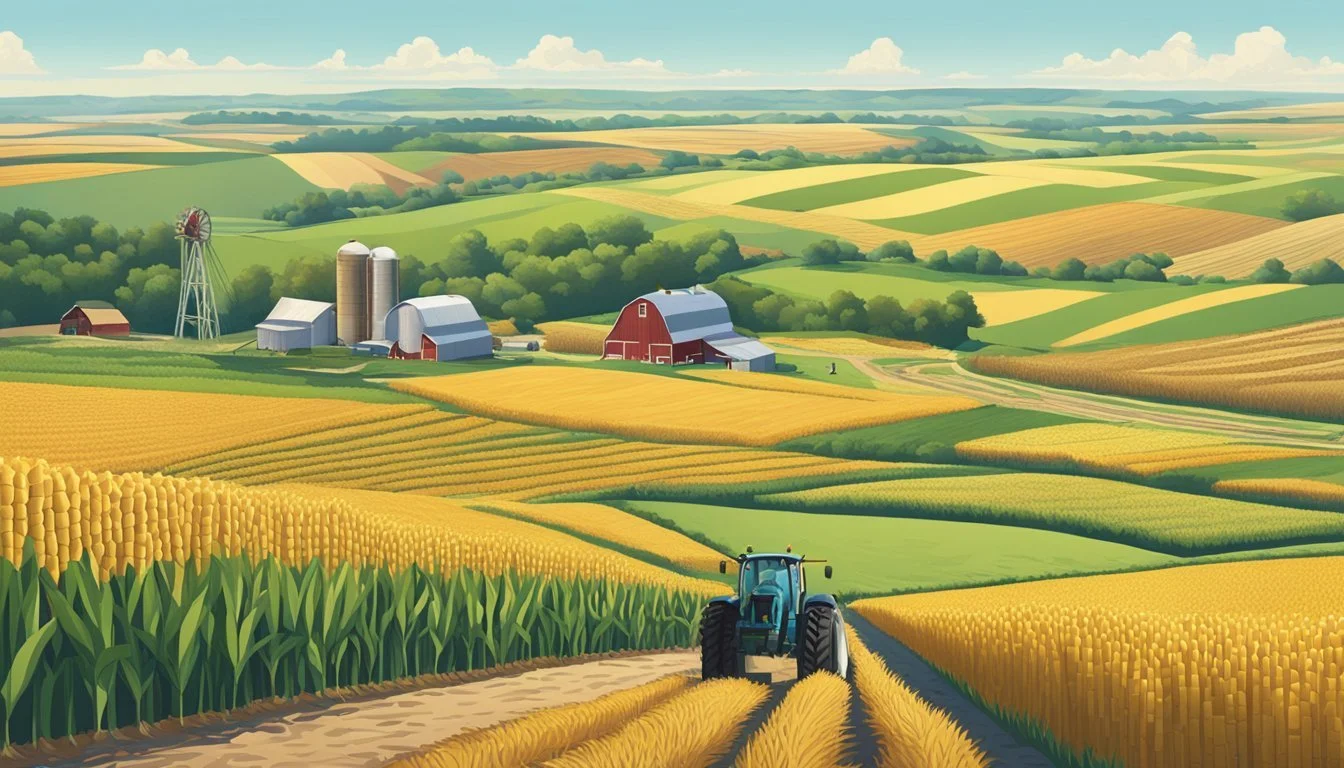Guide to Farming in Nebraska
Essential Strategies for Success
This Article is Part of Our State by State Farming Guide
Nebraska's agricultural heritage is a testament to the enduring spirit of its farmers and ranchers. The state's economy has deep roots in farming, with a landscape that has consistently supported a rich diversity of crops and livestock. Agriculture is not just a business in Nebraska; it represents a way of life that has shaped the identity of the Cornhusker State. With more than 45 million acres dedicated to farming and ranching, agriculture contributes significantly to the state's economy, reinforcing its status as an agricultural powerhouse.
The state's farmers and ranchers have access to an array of resources aimed at fostering growth and ensuring sustainability in the sector. From financial assistance to technical support and educational programs, entities within Nebraska are committed to helping new and established agricultural professionals thrive. Such support underscores the state's commitment to ensuring that the agricultural industry continues to flourish, reflecting the evolving needs of Nebraska farmers and the markets they serve.
Optimizing production in Nebraska's dynamic agricultural environment means embracing both tradition and innovation. With a focus on both crop and livestock production, the state's farmers leverage cutting-edge research and sustainable practices to maintain their competitive edge. This includes transitioning to organic farming, adopting new technology, and implementing advanced management strategies to maximize efficiency and productivity on their farms and ranches.
History of Farming in Nebraska
In the heart of the Midwest, Nebraska's history is deeply rooted in agriculture. Daniel Freeman is recognized for staking the first United States homestead in Nebraska on January 1, 1863. Post-Civil War, Nebraska's population expanded swiftly, leading to its statehood in 1867.
The state's soil proved fertile, allowing agriculture to thrive. Early Nebraska farmers grew crops like sod corn, flax, and potatoes, while also becoming adept at raising livestock. The industry's resilience was further evidenced as farmers adapted to the state's varying precipitation through dry farming methods, especially from the early 20th century.
By the turn of the century, due to the challenges of rainfall variability, novel methods were implemented to cultivate crops effectively using less water. These practices were not just about survival but about prospering in the challenging Plains environment.
In terms of economic impact, agriculture is a linchpin of Nebraska's financial well-being. According to a study, in 2010, the agricultural sector, including the cluster of related businesses, contributed a staggering 41 percent to the state's economy—outlining Nebraska's agriculture as not just historic but also economically vital.
Between 1 CE to 1000, indigenous people had begun a transition to farming, hunting smaller game, and gathering plant foods such as roots and berries. This gradual embrace of agriculture set a foundation for Nebraska's present-day agricultural success, which now stands as a leader in the production of food, feed, and biofuel in the United States, significantly shaping both the state's rural and overall economy.
Climatic Conditions for Agriculture
Nebraska's agricultural success is largely influenced by its climate and weather patterns. Adequate resource management ensures productivity despite climate variability.
Seasonal Weather Patterns
Nebraska experiences a diverse range of weather patterns throughout the year, affecting when and how various crops are planted and harvested. The state sees a clear demarcation of all four seasons, with the planting decisions for agronomic and horticultural crops being significantly impacted by these patterns.
Spring: Farmers typically wait for the soil temperature to reach at least 55°F before planting field corn. This usually occurs around mid-April in southeast Nebraska, late April in central Nebraska, and not until the end of April in the Panhandle area.
Summer: Characterized by warm temperatures that can facilitate rapid crop growth, provided that there is sufficient rainfall or irrigation.
Fall: Harvesting of crops takes place, and preparation for the winter season begins, taking into account the first frost dates which can vary across the state.
Winter: Farming activity slows down as the ground freezes, but it's a critical time for evaluating the previous year and planning for the upcoming season.
Drought Management Strategies
Droughts can pose significant risks to agricultural productivity in Nebraska. Farmers and stakeholders employ strategic drought management to mitigate the impact on crops and livestock.
Monitoring & Preparation: Utilizing resources like the National Centers for Environmental Information to monitor weather patterns and prepare accordingly.
Resource Management: Conservation of water resources and soil moisture is crucial during times of water scarcity.
Diversification: Implementing crop rotation and diversifying crops to include those that are drought-resistant, thus reducing the risk to overall yield.
Educational Resources: Leverage educational programs from the University of Nebraska-Lincoln and Nebraska Extension to stay informed on best practices for drought resilience.
Soil and Terrain Types
Nebraska's soils and terrains are diverse, necessitating a tailored approach to farming that includes effective soil conservation and proper irrigation methods to maintain long-term productivity.
Soil Conservation Techniques
Nebraska farmers employ various techniques to prevent soil degradation and promote sustainable agriculture. Cover Crops are integrated into crop rotations to protect the soil from erosion, enhance soil health, and improve water retention. No-Till Farming reduces soil disturbance, preserving soil structure and organic matter. Farmers also adopt Contour Farming practices, aligning planting with the terrain's natural contours to reduce runoff. In Nebraska, soil conservation is not only about preserving the topsoil but also about maintaining the delicate balance of nutrients. Therefore, Fertilizer Management is critical; farmers use nutrient recommendations to apply the correct type and amount of fertilizer to match the specific needs of their crops without over-applying.
Irrigation Methods
Irrigation is vital in Nebraska, given its variable rainfall patterns. Farmers utilize Center Pivot Irrigation, a system where equipment rotates around a central pivot point, efficiently watering crops with minimal waste. Drip Irrigation is another method, providing water directly to the plant roots, thereby conserving water resources. Nebraska's farmers leverage local resources and technological advancements to optimize water usage, ensuring that crops receive an adequate amount without exhausting water supplies.
The approaches to soil management and water usage are shaped by the state's commitment to both agricultural productivity and environmental conservation.
Major Crops and Production
Nebraska’s agricultural prowess is anchored in its corn and wheat production, which are integral to the state's economic landscape. The state invests heavily in these crops, reflecting in their significant contribution to the national supply.
Corn Cultivation
Corn stands as Nebraska's premier crop, with the state being one of the top producers in the country. Farmers in Nebraska have optimized corn production through advanced irrigation systems, mostly relying on the abundant aquifers for consistent water supply. The state’s climate and fertile soils offer an ideal environment for corn, resulting in:
Planted acres: Nebraska consistently records millions of acres planted with corn each year.
Yield per acre: The state achieves high yield rates, contributing substantially to the nation's corn stocks.
Wheat Harvesting
Aside from corn, wheat is another staple crop in Nebraska, with an emphasis on wheat harvesting techniques to maximize efficiency. Nebraska farmers typically harvest wheat in the early summer, the timing of which is crucial for maintaining grain quality. Wheat production metrics include:
Harvested acres: Farmers allocate a substantial amount of land to wheat, with varying yield depending on the wheat variety.
Production rates: Wheat production rates in Nebraska reflect the adaptability of the crop to the region’s climate.
In summary, Nebraska's agriculture flourishes on the back of its corn and wheat production, utilizing meticulous cultivation and harvesting methods to maintain its status as a key player in the agricultural sector.
Livestock and Ranching
Nebraska's ranching industry plays a central role in the state's agricultural sector, with cattle rearing being a significant activity. Ranchers in Nebraska are known for their expertise in managing vast herds, ensuring both the economic vitality of the industry and sustainability of the resources.
Cattle Rearing
Nebraska stands out in cattle rearing, with ranches effectively utilizing the state's expansive lands for grazing. Ranchers are equipped with knowledge and tools to manage herds across varying landscapes, facing challenges like extreme weather conditions head-on. They focus on key aspects of cattle health and growth, which translates into the consistent production of high-quality beef that Nebraska is known for.
Breeds: Common cattle breeds include Angus, Hereford, and Simmental.
Healthcare: Vaccination and disease management protocols are meticulously followed.
Nutrition: Strategic feeding practices ensure cattle receive balanced diets, enhancing growth and product quality.
Hay Production for Feed
Hay is a staple in livestock feed, especially in Nebraska, where it serves as a critical component of the nutritional regimen for cattle. Nebraska's ranchers often grow their own hay, ensuring a steady supply of quality feed throughout the year.
Types of Hay:
Alfalfa: Highly nutritious, commonly grown in Nebraska.
Grass Hay: Includes varieties like prairie grass, often used in rotation with alfalfa.
The use of locally produced hay not only supports the health and growth of the livestock but also contributes to the self-sufficiency of ranch operations in Nebraska. Proper hay production and storage techniques are crucial to prevent spoilage and maintain the nutritional value of the feed.
Agricultural Equipment and Technology
Nebraska's agricultural prowess is significantly bolstered by advancements in farming equipment and technology. These innovations lead to increased efficiency and productivity on farms throughout the state.
Modern Farming Machinery
Today's Nebraska farms utilize an array of advanced machinery designed to streamline operations and enhance production. Tractors, the backbone of farm mechanization, now come equipped with GPS and autosteer systems. This technology allows for precision navigation across vast fields, ensuring that every inch of soil is effectively used. Combine harvesters equipped with yield monitoring systems enable farmers to assess the productivity of different sections of their land, optimizing future planting strategies.
Planters and Seeders: Accurate seed placement and depth control for optimal growth.
Sprayers: Tailored application of herbicides and pesticides, reducing wastage.
Nebraska farmers harness machinery to work more land with fewer labor inputs, dramatically changing the dynamics of local food production.
Agricultural Software Solutions
In tandem with physical equipment, software solutions play a critical role in Nebraska's agricultural operations. They offer critical data analysis and real-time monitoring, vital for decision-making processes. Farm management software provides a centralized platform to track various aspects of farm operations, from resource allocation to financial management.
Precision Agriculture Tools: Analyze soil conditions and crop health for targeted intervention.
GIS Technology: Mapping fields to manage crops and analyze spatial data.
With these agricultural software solutions, Nebraska producers maintain a competitive edge through meticulous management and utilization of real-time data for their day-to-day and strategic planning.
Farming Economics
In Nebraska, farming economics is not just about the production of crops; it's equally focused on the meticulous management of financial resources and understanding the volatility of crop prices in response to market demands.
Understanding Crop Prices
Crop prices are dictated by a complex interplay of supply and demand, influenced by both local and global market conditions. Nebraska farmers must stay informed about commodity markets, as crop prices directly impact their revenue. Factors affecting prices include weather patterns, crop yields elsewhere, and international trade policies. The use of tools like hedging on futures markets can help farmers manage price risk.
Farm Budgeting and Finance
Effective farm budgeting involves detailed planning and ongoing management of economic resources. In Nebraska, the Agricultural Budget Calculator (ABC) Program offers a platform for farmers to modify or create detailed crop budgets for the year, thereby aiding in making informed financial decisions. Additionally, land values and rental rates offer insights into the local economic climate. Budgeting becomes a strategic tool that helps farmers align their operations with both short-term financial realities and long-term economic sustainability.
State Resources for Farmers
Nebraska offers a wealth of resources for farmers, including comprehensive extension services and financial support through various subsidies and grants. These programs are designed to support farmers in developing successful and sustainable farming operations.
Nebraska Extension Services
Nebraska’s farmers have access to the University of Nebraska's Extension services which provide essential technical assistance and educational resources. Extension specialists collaborate with farmers to enhance agricultural productivity and sustainability. Services include:
Crop Management: Optimal practices for crop production.
Livestock: Guidance on animal husbandry and nutrition.
Integrated Pest Management: Strategies to manage pests efficiently.
Water Resources: Advice on irrigation and water conservation.
Market Development: Assistance in marketing and value addition.
The expertise offered by the University’s extension arms aims to empower farmers with contemporary knowledge and innovative farming techniques.
Government Subsidies and Grants
The state facilitates financial assistance to farmers through various subsidies and grants. Key opportunities include:
Beginning Farmer Program: Grants and loans to support new farmers in land acquisition.
Conservation Programs: Funds for implementing soil and water conservation practices.
Market Development: Initiatives to help farmers access new markets and improve profitability.
Contact Details for Programs:
Program Contact Information Nebraska Extension Services Contact local extension offices Government Subsidies and Grants Nebraska Department of Agriculture website
It is vital for farmers to connect with these resources to stay updated on new agricultural strategies and financial aids.
Energy Use in Agriculture
In Nebraska farming, energy use ranges from conventional fuel consumption to innovative renewable options, displaying a diverse approach to meet energy needs.
Renewable Energy Options
Nebraska's agricultural energy strategy increasingly incorporates renewable energy sources. This involves harnessing wind and solar power, both contributing to a sustainable energy portfolio. Specifically, solar photovoltaic systems have gained traction, with installations providing significant savings, such as a Pennsylvania soybean farm saving approximately $262,000 annually.
Wind Energy: Farms use wind turbines to generate electricity, mitigating reliance on external power sources.
Solar Energy: Solar panels convert sunlight into electricity, offering a clean, cost-effective energy solution for daily farm operations.
Fuel Consumption and Efficiency
Concerning fuel consumption, Nebraska's agriculture sector recognizes the importance of efficiency improvements. The use of fuel-efficient machinery and vehicles is critical. Furthermore, hydrogen energy, a less conventional but promising alternative, is produced using hydrogen fuel cells by combining hydrogen and oxygen, offering a viable avenue for fuel use reduction.
Efficiency Measures: Transitioning to energy-efficient equipment and optimizing fuel use strategies.
Alternative Fuels: Exploring hydrogen as an emerging energy source suitable for agriculture, which could position Nebraska at the forefront of energy innovation in farming.
This strategic approach in Nebraska not only aligns with cleaner energy policies but also provides economic benefits to the farming community through cost savings and potential energy independence.
Agricultural Education and Community
Nebraska's commitment to agricultural education is deeply rooted in its community and academic institutions, playing a key role in shaping the state's number one industry. These educational initiatives not only prepare students for careers in agriculture but also foster community involvement and local food system understanding.
Programs at the University of Nebraska
The University of Nebraska offers a comprehensive portfolio of agricultural education programs aiming to equip students with practical and theoretical knowledge. These programs underscore the integration of teaching, research, and extension services. Students in Lincoln and other campuses can pursue degrees in various agricultural disciplines. The university's curriculum is designed to handle contemporary agricultural challenges and embrace technological advancements in farming.
Undergraduate Programs: These include Bachelor's degrees in agronomy, animal science, and veterinary technology, among others.
Graduate Programs: Advanced studies offered include Master's and Doctorate degrees in agricultural sciences and natural resource management.
Furthermore, the university's connection with the community through extension programs helps disseminate critical agricultural knowledge across Nebraska.
Local Farming Workshops
Local workshops function as a bridge between academic knowledge and practical implementation for the community. These workshops are tailored to address the specific needs of Nebraska's agricultural sectors, focusing on:
Crop management
Sustainable farming practices
Livestock care and production
Farm business planning
They provide farmers and community members with the opportunity to learn from experts in the field, share experiences, and implement new techniques on their own farms. These workshops often foster a sense of community and create a platform for networking among local farmers.
Farming Challenges and Sustainability
In Nebraska, the dynamic landscape of agriculture is shaped by both challenges and strides toward sustainability. Farmers face economic and ecological pressures but are finding ways to adapt through integrated pest management and sustainable practices.
Pest Management
Challenges: Farmers in Nebraska are tasked with effectively managing pests, which can cause significant crop damage and yield loss. Conventional use of pesticides has been the primary tool, but resistance among pests, environmental concerns, and regulatory pressures necessitate new strategies.
Strategies for Pest Management:
Biological control: Utilizing natural predators to curb pest populations.
Crop rotation: Disrupting pest life cycles through diverse planting schedules.
Resistant crop varieties: Planting seed varieties that are less susceptible to pests.
Sustainable Practice Adoption
Sustainability: The adoption of sustainable agricultural practices is essential for the long-term viability of farming in Nebraska. Issues like soil degradation and water scarcity demand a shift from traditional methods to innovative approaches that balance productivity with ecological responsibility.
Keys to Sustainability:
Soil health: Applying fertilizers judiciously to prevent runoff and maintain soil fertility.
Water conservation: Implementing irrigation techniques that reduce water use without compromising crop yields.
Diversified cropping: Encouraging crop diversity to promote ecological balance and reduce dependency on chemical inputs.










